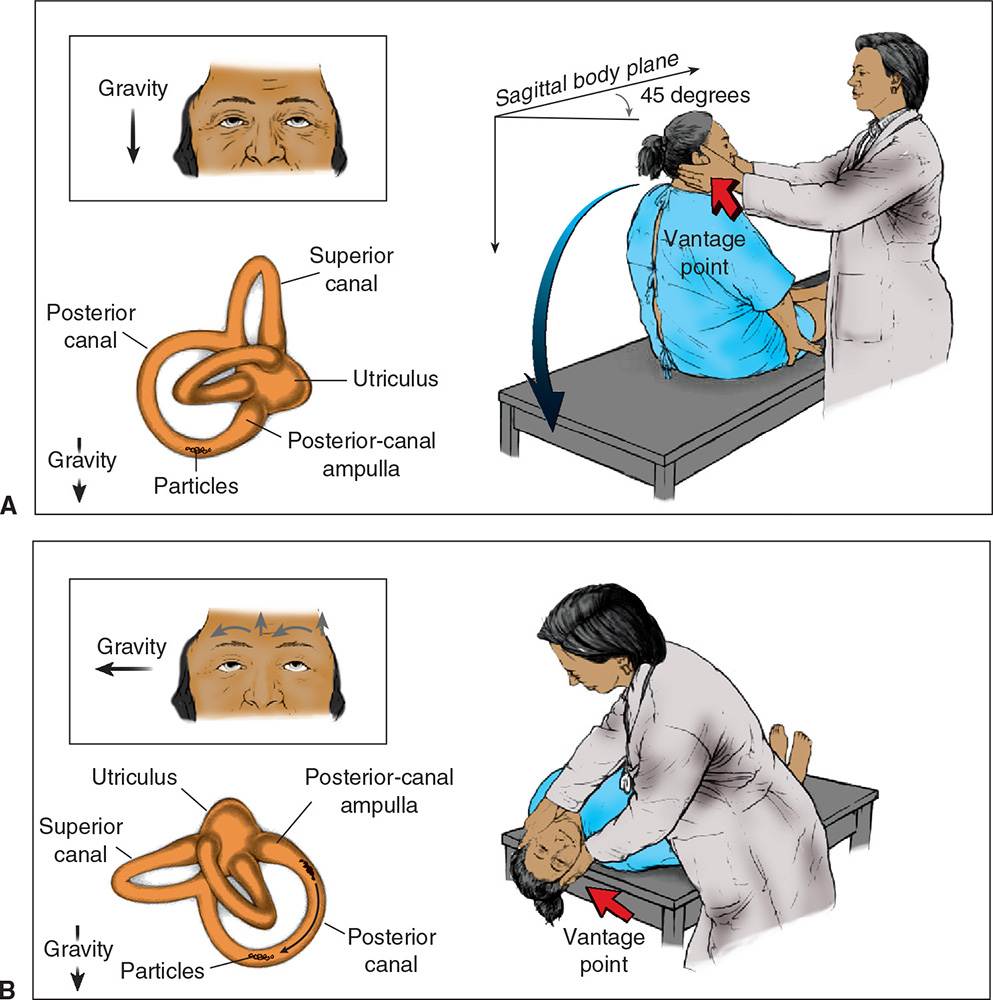![]() Used to confirm the diagnosis of benign paroxysmal positional vertigo (BPPV) of the posterior semicircular canal
Used to confirm the diagnosis of benign paroxysmal positional vertigo (BPPV) of the posterior semicircular canal
CONTRAINDICATIONS
![]() Unstable heart disease
Unstable heart disease
![]() Ongoing cerebrovascular ischemia
Ongoing cerebrovascular ischemia
![]() Severe cervical degenerative arthritis
Severe cervical degenerative arthritis
![]() High-grade carotid stenosis
High-grade carotid stenosis
RISKS/CONSENT ISSUES
![]() There have been no reported serious adverse events such as neck fracture or carotid artery dissection
There have been no reported serious adverse events such as neck fracture or carotid artery dissection
![]() Warn the patient that he will become symptomatic during the procedure, but that this will be transient. Inform the patient that this response is actually very useful.
Warn the patient that he will become symptomatic during the procedure, but that this will be transient. Inform the patient that this response is actually very useful.
![]() Rarely the patient may vomit. In general, premedication is not needed.
Rarely the patient may vomit. In general, premedication is not needed.
LANDMARKS
The Hallpike test diagnoses the inappropriate presence of otoliths in the posterior semicircular canal. This canal is oriented 45 degrees from the vertical axis (FIGURE 47.1).
TECHNIQUE
![]() The patient is sitting upright in the gurney and positioned far enough back such that when he lies down, his head will overhang the edge of the gurney
The patient is sitting upright in the gurney and positioned far enough back such that when he lies down, his head will overhang the edge of the gurney
![]() Warn the patient that you are going to lower him and that he may become symptomatic. Instruct the patient to keep his eyes open as it is important for you to document both the presence and direction of nystagmus.
Warn the patient that you are going to lower him and that he may become symptomatic. Instruct the patient to keep his eyes open as it is important for you to document both the presence and direction of nystagmus.
![]() Turn the patient’s head 45 degrees to one side before tipping him backwards. This will orient the posterior canal into the same plane as the upcoming movement into the head-hanging position.
Turn the patient’s head 45 degrees to one side before tipping him backwards. This will orient the posterior canal into the same plane as the upcoming movement into the head-hanging position.
![]() Have the patient lie in the head-hanging position, supporting the patient’s head with your hands. This does not need to be done overly rapidly (should be done over several seconds).
Have the patient lie in the head-hanging position, supporting the patient’s head with your hands. This does not need to be done overly rapidly (should be done over several seconds).
![]() If otoliths are present, there is usually a few seconds, delay (but not longer than approximately 10 seconds)
If otoliths are present, there is usually a few seconds, delay (but not longer than approximately 10 seconds)
![]() The patient will develop reproduction of his symptoms and, usually, nystagmus. This indicates a positive test. Many patients will reflexively close their eyes and you may need to open their eyelids.
The patient will develop reproduction of his symptoms and, usually, nystagmus. This indicates a positive test. Many patients will reflexively close their eyes and you may need to open their eyelids.
![]() Carefully observe the direction of the nystagmus
Carefully observe the direction of the nystagmus
![]() Direction of nystagmus is defined as the direction of the fast phase
Direction of nystagmus is defined as the direction of the fast phase
![]() Classic nystagmus in this situation is upbeat (toward the forehead) and ipsilateral (toward the involved side), as well as torsional/rotatory
Classic nystagmus in this situation is upbeat (toward the forehead) and ipsilateral (toward the involved side), as well as torsional/rotatory
![]() Downbeat or vertical nystagmus can indicate a central cause of vertigo and requires further evaluation
Downbeat or vertical nystagmus can indicate a central cause of vertigo and requires further evaluation
![]() Help the patient back to the sitting up position
Help the patient back to the sitting up position
![]() Most patients will become dizzy from orthostasis, and it is important to distinguish this from positional vertigo
Most patients will become dizzy from orthostasis, and it is important to distinguish this from positional vertigo
![]() If a patient had a positive result on Hallpike test, the eyes usually reverse direction when the patient sits up
If a patient had a positive result on Hallpike test, the eyes usually reverse direction when the patient sits up
![]() Test both sides; apart from the rare situation in which otoliths are present bilaterally, this test should be positive on one side and negative on the other
Test both sides; apart from the rare situation in which otoliths are present bilaterally, this test should be positive on one side and negative on the other

FIGURE 47.1 The Dix–Hallpike test of a patient with benign paroxysmal positional vertigo affecting the right ear. (From Furman JM, Cass SP. Benign paroxysmal positional vertigo. N Engl J Med. 1999;341:1590–1596, with permission.)
Stay updated, free articles. Join our Telegram channel

Full access? Get Clinical Tree


